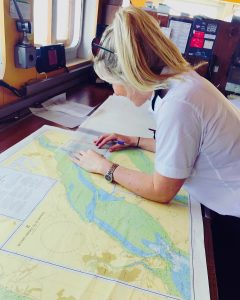
Discover how women are reshaping the maritime industry. Learn about the barriers they face, the policies and mentorships that support them, and how inclusive shipboard culture can steer global shipping toward gender equality.
Why Women in Maritime Matter in Today’s Industry
For centuries, the maritime industry was one of the most male-dominated sectors in the world. Ships were considered no place for women, and superstitions even deemed their presence at sea unlucky. But tides are turning.
Today, the maritime sector is not only beginning to welcome women into its ranks — it’s recognising that their presence is essential for a sustainable and equitable future. From engine rooms to captain’s chairs, women are proving they belong onboard and in maritime leadership. According to the IMO-WISTA Women in Maritime Survey Report (2021), women make up just 1.2% of the global seafaring workforce, but the number is growing steadily.
Yet, challenges remain. Cultural resistance, lack of mentorship, gender-based harassment, and inadequate policies still limit women’s participation. This article explores the barriers women face, what has worked in breaking them down, and how we can build a more inclusive and safe industry for all.
–
Barriers Women Face in Maritime Training and Leadership
Institutional Barriers and Gender Bias
Maritime academies and training institutes are slowly becoming more inclusive, but women still report facing systemic barriers during their education. Gender bias can manifest in subtle ways: being discouraged from engine room tracks, getting fewer hands-on opportunities, or being left out of group projects.
A study by the World Maritime University (WMU, 2020) revealed that 35% of female cadets experienced discrimination during training, while 20% felt their competence was questioned more than their male peers’. These experiences shape career paths long before women step aboard a ship.
Onboard Culture and Harassment
A major hurdle lies in shipboard culture. The 2023 ILO-ICS-WISTA Joint Report on Diversity at Sea revealed that 60% of women seafarers have experienced or witnessed harassment onboard. The combination of isolation, lack of reporting mechanisms, and male-dominated environments makes it hard for women to feel safe or empowered.
Even well-intentioned crews can contribute to exclusion through casual sexism, lack of proper accommodation (e.g., shared bathrooms), or paternalistic attitudes. These factors drive women to abandon maritime careers early, a phenomenon dubbed “leaky pipeline” by diversity advocates.
Career Progression and Leadership Gaps
Fewer than 2% of ship captains are women, according to Lloyd’s List Intelligence. The road to maritime leadership is long and demanding for anyone, but women often encounter invisible ceilings. These include assumptions about physical strength, family responsibilities, and availability for long contracts.
Moreover, shipping companies often promote from within — but if women aren’t given operational roles early, they’re excluded from the leadership pipeline by default.
Building Inclusive Onboard Cultures: What Really Works
Leadership Buy-In and Policy Enforcement
Inclusion can’t thrive without commitment from the top. Shipping companies that publicly commit to gender equality and back it up with concrete actions are seeing real results. Maersk Line, for instance, launched an internal gender equity audit in 2021 and revised its HR practices, leading to a 45% increase in female officer recruitment over two years.
Policies are also key. The IMO Model Course on Gender Equality Leadership (2023) now provides a structured framework for companies to implement inclusive recruitment, onboarding, and reporting mechanisms.
Gender-Sensitive Accommodation and Safety
Practical adjustments onboard are essential. Dedicated cabins, private bathrooms, and PPE designed for women are not luxuries — they are requirements for dignity and safety. The International Chamber of Shipping (ICS) has issued updated guidelines on onboard living arrangements to support mixed-gender crews.
Safety is non-negotiable. Enforced anti-harassment policies, zero-tolerance clauses in contracts, and training in respectful behavior all contribute to a supportive work environment.
Inclusion Training for Mixed Crews
Training programs like WISTA’s “SheFarers” toolkit or the ILO-WMU Gender Equality Modules equip crews with awareness and tools to support their colleagues. Inclusion isn’t just a checklist — it’s a mindset. Companies that invest in cultural competency see lower crew turnover and higher morale.
Celebrating Role Models and Representation
Seeing is believing. Female captains like Captain Radhika Menon (India), the first woman to receive the IMO Award for Exceptional Bravery at Sea, and Captain Belinda Bennett (St. Helena), Windstar Cruises’ first black female cruise captain, break stereotypes and open doors.
When women in maritime are featured in company newsletters, conference panels, or recruitment videos, it changes perceptions not just onboard, but across the industry.
–
What’s Working: Success Stories and Real Progress
Philippines: Maritime Education With an Inclusive Edge
With one of the world’s largest seafaring populations, the Philippines has started incorporating gender-inclusive policies in maritime education. Maritime Academy of Asia and the Pacific (MAAP) now enrols more women and provides leadership development opportunities. Female cadets report increased mentorship and a clear sense of belonging.
Ghana: WIMA Africa’s Empowerment Programs
Women in Maritime Africa (WIMAfrica) in Ghana is actively mentoring young women through partnerships with maritime authorities. Their outreach programs in schools and ports aim to build confidence and provide career pathways. In 2022 alone, they facilitated internships for over 200 women in logistics and shipping operations.
Scandinavia: Gender Targets and Innovation
Scandinavian countries like Norway and Sweden, known for their progressive gender policies, are leaders in maritime inclusion. DNV set internal diversity goals in 2020 and now reports 32% female representation in middle management, up from 18%.
In 2023, the Norwegian Maritime Authority partnered with maritime unions to provide mentoring programs for young female officers transitioning from cadet roles to officer positions.
–
The Role of Policy, Mentorship, and Safety in Encouraging Women to Sea
National and International Policies
IMO, in collaboration with ILO and UN Women, continues to drive regulatory change. The IMO-WISTA Women in Maritime Programme promotes institutional partnerships and has launched scholarships, leadership training, and regional conferences.
Flag states are also stepping up. Australia’s AMSA, Canada’s Transport Ministry, and the EU Maritime Strategy all include gender parity goals and funding for training female seafarers.
Classification societies like BV and ABS now include diversity assessments in company audits.
Mentorship as a Bridge to Leadership
Mentorship connects junior women to experienced professionals who can guide, support, and advocate for them. Programs like WISTA International Mentoring, SheEO Maritime, and Lloyd’s Maritime Academy Diversity Initiative match female cadets and officers with mentors who understand both the technical and social challenges of maritime careers.
These programs have shown measurable impact. A 2023 survey by The Nautical Institute found that 68% of women who had mentors were still working at sea after five years, compared to just 29% without mentorship.
Safety: Creating a Culture of Trust
Women will only choose sea careers if they trust that they will be safe and respected onboard. This means robust reporting channels, anonymous grievance procedures, and swift response to complaints.
ITF Seafarers’ Trust and ILO have developed safety protocols specific to gender-based violence, encouraging ships to treat harassment as a safety hazard, not just a disciplinary issue.
–
FAQ
Why are there still so few women in shipping?
Systemic barriers in education, recruitment, and onboard culture discourage women from joining or staying in the maritime sector.
Are women strong enough to work at sea?
Yes. Seafaring requires skill, endurance, and leadership — not brute strength. Women have proven themselves capable across all vessel types.
How can maritime companies attract more women?
Inclusive policies, visible role models, mentorship programs, and onboard safety initiatives are key to attracting and retaining women.
What is the IMO doing to support women in maritime?
The IMO runs several programs, including the Women in Maritime Programme, gender equality model courses, and partnerships with WISTA.
Is harassment at sea being addressed seriously?
Yes, but not universally. Some companies and flag states are proactive, while others lag behind. Global standards are improving, especially with IMO and ILO collaboration.
How can men onboard support inclusion?
By treating women as equal professionals, reporting inappropriate behaviour, and fostering a respectful work environment.
Conclusion
Women have always played roles in maritime history, but only now are they beginning to be fully recognised and empowered as seafarers, engineers, and leaders. While progress is being made, the maritime world must move faster and more deliberately to dismantle barriers and build a truly inclusive culture.
Shipping companies, flag states, training institutions, and maritime organisations each have a role to play. Whether it’s revising policies, funding mentorship, or simply giving women a fair chance to succeed, the path to inclusion is clear.
As more women take the helm, they are not only charting their own course — they are steering the industry toward a future that is diverse, just, and resilient. It’s time we all help them navigate.
References
- IMO-WISTA Women in Maritime Survey Report 2021
- ILO-ICS-WISTA Report on Diversity at Sea 2023
- World Maritime University Gender Report 2020
- WISTA International Mentoring Programme
- SheFarers Toolkit
- DNV Diversity Report 2023
- Maersk Gender Equity Audit 2023
- ICS Guidance on Mixed-Gender Crews
- ITF Seafarers Trust Gender Safety
- Nautical Institute Mentoring Survey
- ABS Gender Policy Guidelines
- AMSA Gender Equality Strategy
- EU Maritime Transport Strategy 2020–2030


